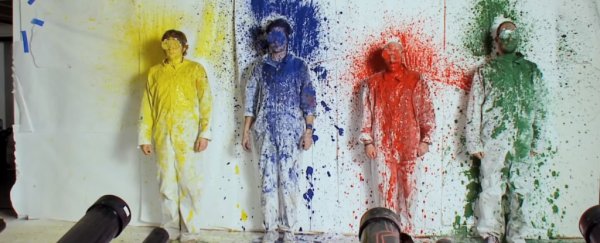Microsoft announced on Thursday that it has set a new record by storing 200 megabytes of data on strands of synthetic DNA. That's about 20 times the previous record.
Back in April 2016, Microsoft Research bought 11,000 custom-made synthetic DNA molecules from Twist Biosciences, a San Francisco startup. The idea was to look into the idea of using DNA molecules as a way to store massive amounts of data.
Unlike hard drives, Blu-Ray discs, or pretty much any current storage technology, DNA stays intact and readable for as long as 1,000 to 10,000 years.
With this announcement, only a few months later, the science is starting to bear fruit.
Microsoft was able to successfully encode and then decode a bunch of data to DNA strands, including the Universal Declaration of Human Rights in more than 100 languages, the top 100 public domain books from Project Guttenberg, the Crop Trust's seed database, and the high-def music video to OK Go's "This Too Shall Pass".
Why OK Go in particular? Because the video's Rube Goldberg-inspired machinery required the band to bring in lots of outside help from all kinds of cross-disciplines, much like how Microsoft Research had to bring in biologists and computer scientists alike from Twist and the University of Washington to help break this DNA storage record.
"They're very creative and they bring a variety of other areas into their work," Microsoft Research DNA storage project lead Karin Strauss told Business Insider. "We see parallels with our work."
Two hundred megabytes of data may seem measly. After all, the most basic iPhone holds 16 gigabytes, or 16,000 megabytes.
And with an average price-per-gigabyte falling to less than US$0.03 in 2016, it's both cheaper and easier than something crazy like storing data on DNA. That's why Microsoft is thinking bigger.
"Initially, what makes the most sense for DNA is archival storage," says Strauss.
Doesn't degrade
While it will be a long time before it's as fast and as cheap as the solid-state drive that goes into a smartphone, DNA has the potential to be perfect for storing archives of big files, like movies and video, over long periods of time - hard drives, USB drives, tapes, and CD/DVDs degrade over decades, but this synthetic DNA could outlast us all.
That's why books and videos were chosen for this particular project, Microsoft says: to highlight how DNA storage could preserve culture over the long term, even as other technologies come and go. After all, as long as there are humans, there will be DNA, and likely the tools to analyse it.
Ultimately, Microsoft Research estimates that one cubic millimetre of DNA can eventually store one exabyte, or one billion gigabytes of data. But the science is handicapped by the fact that it's tough to actually store that much data.
DNA storage could become especially useful as the rise of the smartphone era means we're generating more photos, video, text, and audio than ever before.
While the technology is very real, scientists need to figure out better ways to quickly and automatically encode the data into DNA. Right now, it's a slow, painstaking process, which is why it's only 200 megabytes.
Still, Straus is confident that in the same way hard drives got smaller, cheaper, and faster over the years, so too will DNA storage.
"That's pretty much how all memory technology evolves," Strauss says. "The scaling needs to improve."
Scientists are also still working on the best way to decode the data once it's stored in DNA. So while it might seem really cool to have OK Go's music stored in the new DNA-format, don't expect to watch the video just yet: unless, you happen to have a DNA sequencer in your living room.
This article was originally published by Business Insider.
More from Business Insider:
